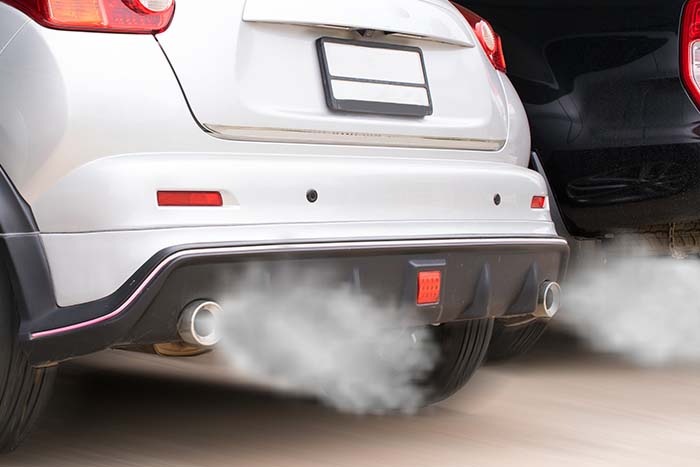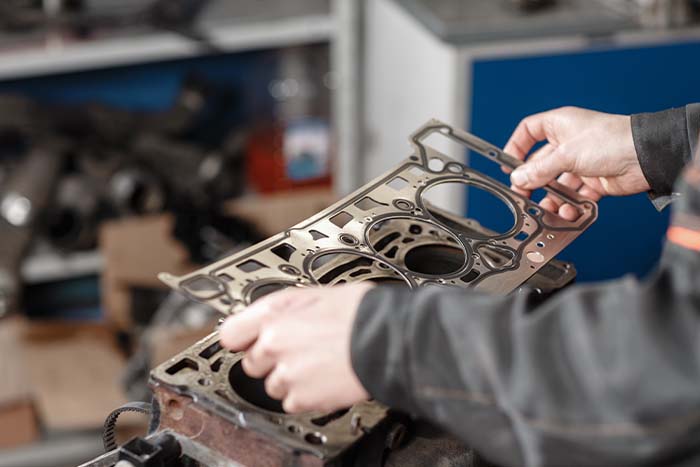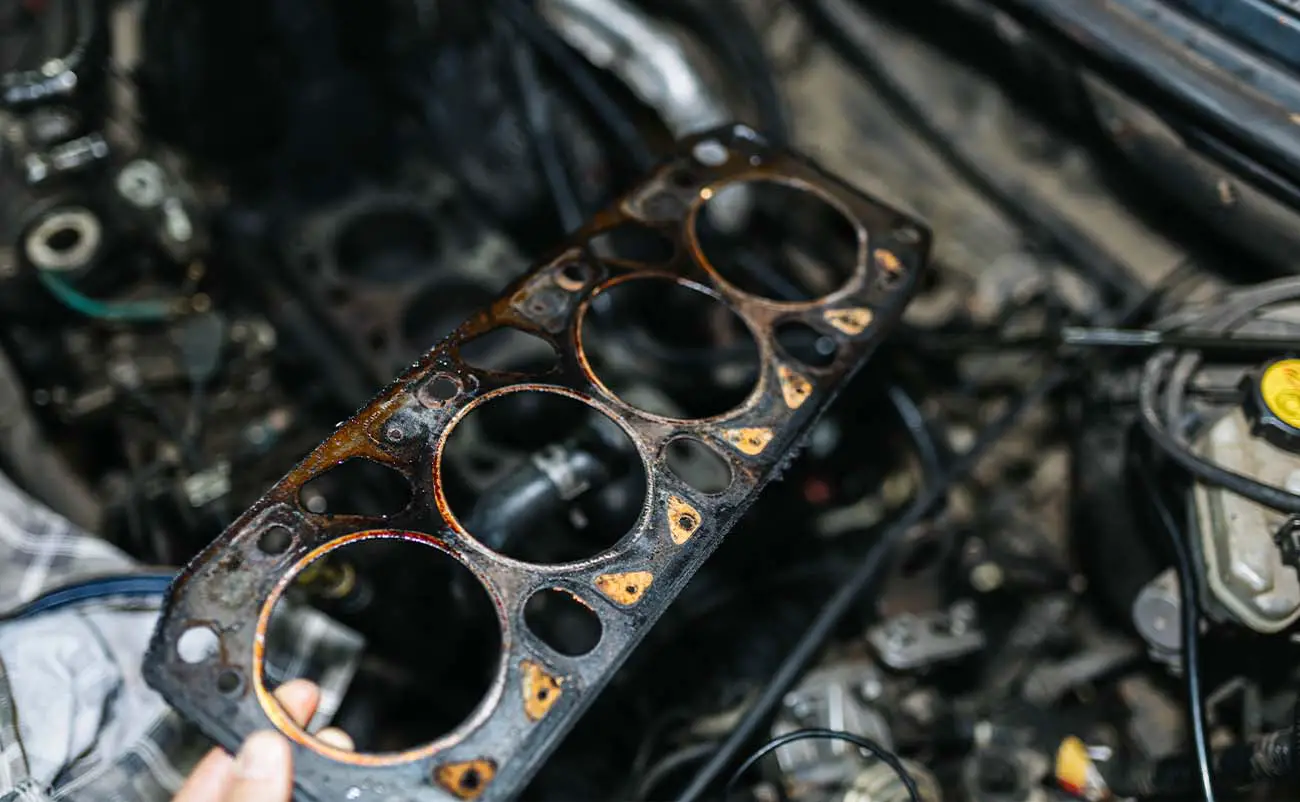A blown head gasket is never good, and your repair bill is usually quite high to fix one. Sometimes, however, you might still be driving your car with a blown head gasket without even realizing it. Continuing to drive it could do even more damage to your engine, which means an even higher bill at the repair shop. So, how do you tell if you have a bad head gasket? There are several blown head gasket signs that you can watch for, and we are here to tell you exactly what you need to know about them. If your car shows any of these symptoms, you should have it checked by a mechanic right away.
Table of Contents
6 Signs Of A Blown Head Gasket

Many people wonder how to tell if you have a blown head gasket. Like we already mentioned, you might notice your car running a little strange but not overthink about it. However, you might need to take it more seriously if you think the head gasket might be the issue. Here are the six things you need to watch for that could signal a blown or leaking head gasket.
#1. Mixing Of Oil And Coolant
Your head gasket seals your cylinder heads to your engine block. There are small coolant passages inside the block and the heads through which coolant passes in order to remove excessive heat from the engine. That is a crucial part of your cooling system. However, if the head gasket is blown, then a proper seal is not formed. As the coolant flows, it will leak into the engine and mix with the oil.
Similarly, engine oil might find its way into the cooling system. So, if you notice the coolant in the overflow tank or radiator is dark and murky, then you might have a problem. Likewise, if the oil on your dipstick is milky or frothy, then your head gasket might be shot.
#2. Coolant Leaks
The cause of this issue is essentially the same as the problem described above. You might not notice your coolant and oil mixing yet, but perhaps you notice coolant leaking from the engine. If you see coolant on the ground or on your engine, then you should take a closer look. Try and determine where the leak is coming from. When coolant leaks from around your cylinder heads, this almost always signals a head gasket failure.
#3. Overheating
When your head gasket goes bad and loses its seal, the coolant can no longer circulate properly through the engine block and heads. When this happens, it means that your cooling system is not working correctly. If the coolant is not circulating, then all the heat from the engine is not being removed. This can quickly cause your vehicle to overheat. Keep an eye on your temperature gauge. When you notice the temperature getting too high, then shut off the engine immediately. Engine overheating can also lead to additional engine damage like a cracked engine block or warping of the pistons. It would be best if you got the issue diagnosed and corrected right away.
#4. Loss Of Compression
As your engine runs, pressure builds inside the combustion chamber as the pistons compress the air-fuel mixture. For this pressure to increase correctly, there must be a complete seal around the chamber. A bad head gasket does not form a proper seal, so air leaks out of the chamber as the pressure starts to build. This causes a loss of compression in that particular cylinder. If your head gasket is completely blown, then you might lose compression in multiple cylinders. This will cause your car to run very rough or maybe even not crank at all. A mechanic can perform a compression test to determine which cylinders are affected. If you have a loss of compression, then the head gasket is the most common culprit.
#5. Bubbling In The Radiator
If you hear bubbling in your radiator, that might be bad news. When the car is cool, you can even remove the radiator cap and watch for bubbles. A head gasket leak can cause air to enter the cooling system. This can result in bubbles in the radiator as the coolant circulates through the system and the air tries to escape. Always keep a check on your coolant levels, and if you see or hear bubbles in your antifreeze, then you should have a mechanic check your vehicle for a bad head gasket.
#6. White Smoke From Tailpipe
We’ve already discussed how a blown head gasket can lead to engine coolant entering the combustion chamber. When this happens, it can cause more problems than just mixing with the oil. When antifreeze burns, it produces a cloud of white smoke. So, if coolant enters the chamber and gets burned, the combustion gases will have white smoke in them. This smoke will exit through the exhaust system and out the tailpipe. This is one of the most common signs of a blown head gasket. In addition to the smoke, you might also notice a rough idle, engine misfires, loss of power, or fouled spark plugs as well.
What Is A Head Gasket, And What Does It Do?
A head gasket is the piece of material that forms an airtight seal between your engine block and cylinder heads. It can be made from several different head gasket materials, and the most common is multi-layer steel. This type of head gasket is often the strongest and most durable, and it consists of several skinny layers of steel joined together with a binding material like rubber. You might also find head gaskets made of a composite material, felt, cork, and even copper. Copper head gaskets are generally reserved for high-performance applications.
Your head gasket is a critical piece of your car’s engine. Without the seal formed by the head gasket, your engine would lose compression, and your cooling system would not work correctly. In addition, you might also have oil leaks which could lead to a lack of lubrication for the internal parts of your engine. These are all reasons why you should have your car repaired right away if you notice any of the blown head gasket symptoms mentioned above.
What Causes A Blown Head Gasket?
While head gaskets usually last for quite some time, they are bound to fail eventually. The constant exposure to heat and pressure as your engine is running will ultimately cause them to fail. Many cars go well over 100,000 miles without any head gasket problems at all. If your gasket fails early, it is almost always due to one of a couple of reasons. The first is overheating. If you allow your vehicle to overheat, this can cause detrimental damage to your head gasket. The gasket is designed to last for years under normal operating temperatures, but most head gasket materials cannot withstand extremely excessive heat for very long.
Another common culprit is excessive pressure inside your engine. This usually happens when you have added an aftermarket performance part like a turbocharger or supercharger. These parts cause the compression in your engine to rise above the normal level. This excessive pressure can easily blow out a head gasket. Most people who add these parts also decide to add an upgraded head gasket to avoid this problem.
Cost To Repair A Bad Head Gasket

Whether your head gasket fails early due to some other issue or it finally gives way at 200,000 miles, you will find yourself needing a head gasket repair eventually. So, how much is that going to cost you? Your blown head gasket repair cost might depend on the severity of the leak. If you have a minimal leak in the head gasket, you might be able to get away with a bottle of head gasket sealer. You pour the bottle into your cooling system and allow it to circulate. If the leak is small enough, then the sealant can fill the gap and stop the leak without replacing the head gasket. A bottle of this sealant will run you $20 to $30 in most cases. Since it is so cheap, it is usually worth a try!
At other times, you may need a head gasket replacement. In that case, you can expect that your repair bill will be much higher. Replacing a head gasket is not an easy job, and it will take an experienced mechanic several hours to perform the job. You can expect a bill of approximately $750 to $1,000 when your head gasket blows. Unless you are a reasonably experienced mechanic, this is not a job that you should tackle on your own. If, however, you think you can handle it, you can save yourself quite a bit of money. Most head gasket kits can be purchased for around $200, so you could save several hundred dollars on labor costs by doing the work on your own.
The Bottom Line
A blown head gasket can be a pain, and it can cause a lot of damage to your engine if not repaired right away. There are several common symptoms that you will notice when your head gasket blows, so be on the lookout for the signs mentioned above. If you see your car doing any of the things we have described, you should have it repaired right away to avoid additional problems!
Frequently Asked Questions
Can you still drive a car with a blown head gasket?
Sometimes your car might still run and drive even after the head gasket starts to leak. However, it is never a good idea to drive a car with a blown head gasket. Continuing to drive will lead to additional damage. Your vehicle is likely to overheat, create a lot of smoke, or maybe lose compression. None of these things are good while trying to drive, so it is best to park your vehicle until you can get it repaired.
Is it worth fixing a blown head gasket?
It probably depends on the value of your vehicle. If you have a car that has no other significant issues and you expect to continue driving it, then you should probably go ahead and get it repaired. However, if the car is ancient and has several other problems, then you might not want to sink that much money into it. You could sell the vehicle to a junk car buyer and use that money to buy a new car that does not have any issues.
Does a blown head gasket ruin an engine?
A blown head gasket usually does not ruin an engine if you stop driving the car right away and have it repaired. However, continuing to drive the vehicle can lead to additional damage that will ruin the engine. If you keep driving with a bad head gasket, you might end up with warped pistons or a cracked engine block. Those things can certainly ruin an engine, and you might find yourself needing a total engine replacement instead of just a new head gasket.
How do you fix a blown head gasket?
In some cases, you might be able to fix it by simply pouring a bottle of head gasket sealer into your cooling system. However, this only works for tiny leaks in the gasket. If the head gasket is completely blown, you will need to replace the gasket with a new one. This requires removing the cylinder head, cleaning the surface, replacement with a new gasket, and reassembling the engine. It is a tough job that usually requires an experienced mechanic to complete.


We absolutely love your blog and find nearly all of your post’s to be just what I’m looking for. can you offer guest writers to write content for you personally? I wouldn’t mind writing a post or elaborating on a few of the subjects you write regarding here. Again, awesome weblog!